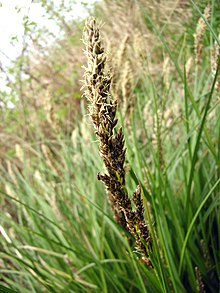Großseggenried
Large sedge beds , also large sedge swamps or large sedge societies are a type of biotope and an association in plant sociology (fen-Großseggenrieder, Magnocaricion ) and consist mainly of larger sedges as well as a few flowering fen plants. They only occur in very humid locations. These can be very extensively used meadows or unused, near-natural swamps. A relative poverty of species and structures and a mostly quite uniform height of between 50 and 100 cm are typical. Stands of the stiff sedge also grow up to man-high. Sedge Riede, complexes within larger reeds form surfaces or even small reed beds and willow bushes included.
The stock-forming sedges can show grassy or rather bulky growth forms. For example, swamp sedge ( Carex acutiformis ), slender sedge ( C. acuta ) and bank sedge ( C. riparia ) form grassy stands, while blackhead sedge ( C. appropinquata ) and stiff sedge ( C. elata ) grow tall. or panicle sedge ( C. paniculata ).
Spread and endangerment
Large sedge beds were widespread in the river lowlands and lynx landscapes of Central Europe well into the 20th century , which can be seen, among other things, from the historical distribution of bird species such as the sedge warbler and the double snipe. Due to drainage and amelioration measures, this locally typical landscape form, which was widespread at the time, has shrunk to small remnants. Larger, contiguous sedge beds in Germany are usually only found in nature and landscape protection areas, such as the Dümmer , the Drömling , the Elbhöhen-Wendland nature park or the moors in the Peene Valley . Larger occurrences of this type of landscape, which give an impression of the former extent, are only found in the largely natural river systems of Eastern Europe, such as at Biebrza and Pripjet .
Plant sociology
The association of large sedge societies Magnocaricion belongs to the class of "freshwater reed and large sedge" Phragmitetea (after Oberdorfer Phragmitetalia ). In addition to the swamp sedge and the panicle sedge, the marsh sedge , the ostrich-flowered loosestrife and the marsh skullcap belong to the character types . Some associations are:
- Steifseggenried ( Caricetum elatae )
- Schlankseggenried ( Caricetum gracilis )
- Schnabelseggenried ( Caricetum rostratae )
Breeding bird species
As a species that specializes in this habitat, the reed warbler should be emphasized, which is endangered due to the rarity of this habitat. The closely related reed warbler occurs above all where the monotonous stocks of sedges are broken through by willows, loose reeds or ditches or are adjacent to reeds . Other characteristic species are common snipe , double and dwarf snipe , black godwit , spotted moorhen and corncrake .
Großseggenriede also provide a suitable habitat for both reed- dwelling species and meadow bird species. However, the former sometimes occur in a lower settlement density than in reed beds, the latter only in certain low, not too dense and not waterlogged areas. The reed-dwelling species include reed bunting , pond warbler and water rail . The meadow birds include ruff , lapwing , curlew , redshank , meadow pipit and whinchat .
Species that breed on the edge of stagnant waters can also be found in ponds and ravines in Großseggenried. These include coot , black tern and various types of ducks .
literature
- O. Wilmanns: Ecological Plant Sociology UTB, Quelle & Meyer, Heidelberg / Wiesbaden 1989, ISBN 3-494-02168-6 .
- M. Flade: The breeding bird communities of Central and Northern Germany: Basics for the use of ornithological data in landscape planning , IHW-Verlag, Eching 1994, ISBN 3-930167-00-X .
Individual evidence
- ↑ Flade (1994), p. 164, p. literature

